Multi-tiered hedges create dramatic depth by layering plants of varying heights, textures, and seasonal interest. Place taller species in the back and shorter plants in front, allowing 3-5 feet between rows for proper growth. Combine evergreens for structure with flowering natives to support wildlife and provide year-round visual appeal. Use staggered planting patterns and odd-numbered groupings for natural aesthetics. Your thoughtfully designed living boundary will transform your landscape while nurturing local biodiversity.
Understanding the Principles of Multi-Tiered Hedge Design
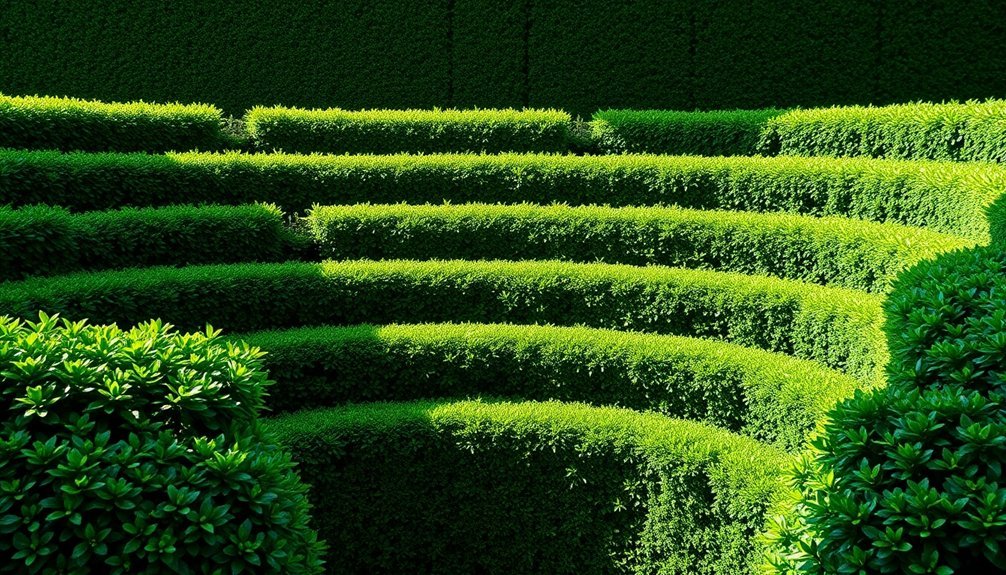
While single-row hedges serve basic functions, multi-tiered hedges transform landscapes through strategic layering and thoughtful design. By configuring multiple layers, you'll maximize both visual impact and ecological benefits in your outdoor space.
Start with a thorough site analysis, evaluating sunlight exposure, soil conditions, and prevailing winds. These factors will determine which plants will thrive in each layer of your hedge system.
Whether you're working with a narrow strip or a wide expanse, multi-tiered designs can be adapted to utilize available space effectively.
The layering approach isn't just aesthetically pleasing—it supports essential ecological goals. You'll create diverse habitats that encourage biodiversity while establishing sustainable landscape elements. The strategic placement of different plant heights creates important ecotones that dramatically increase the diversity of species your landscape can support.
The combination of different textures, heights, and colors creates dynamic visual interest that single-row plantings simply can't match.
Selecting Compatible Plants for Successful Layering
The success of your multi-tiered hedge depends fundamentally on selecting plants that not only complement each other visually but also coexist harmoniously in shared growing conditions.
Consider combining evergreens like American Arborvitae with deciduous options such as 'Autumn Brilliance' serviceberry for year-round structure plus seasonal interest.
A thoughtful blend of evergreen anchors with deciduous highlights creates a hedge that captivates throughout all seasons.
Match growth rates to your design intent—fast-growing Chindo Viburnum can quickly establish a backdrop while slower American Holly provides controlled middle layers.
Choose plants that thrive in your specific conditions. For wet areas, try Viburnum × rhytidophylloides; for dry spots, Yew Plum Pine works well.
Create visual depth by mixing textures and forms—pair conifers with broadleaf evergreens for contrast.
Don't forget wildlife benefits—incorporate berry-producing natives that support local birds and pollinators while enhancing your hedge's ecological value. Utilizing a mixture of plant types creates a more resilient hedge that can withstand various environmental stresses while offering maximum ecological benefits.
Proper Spacing and Arrangement for Maximum Visual Impact
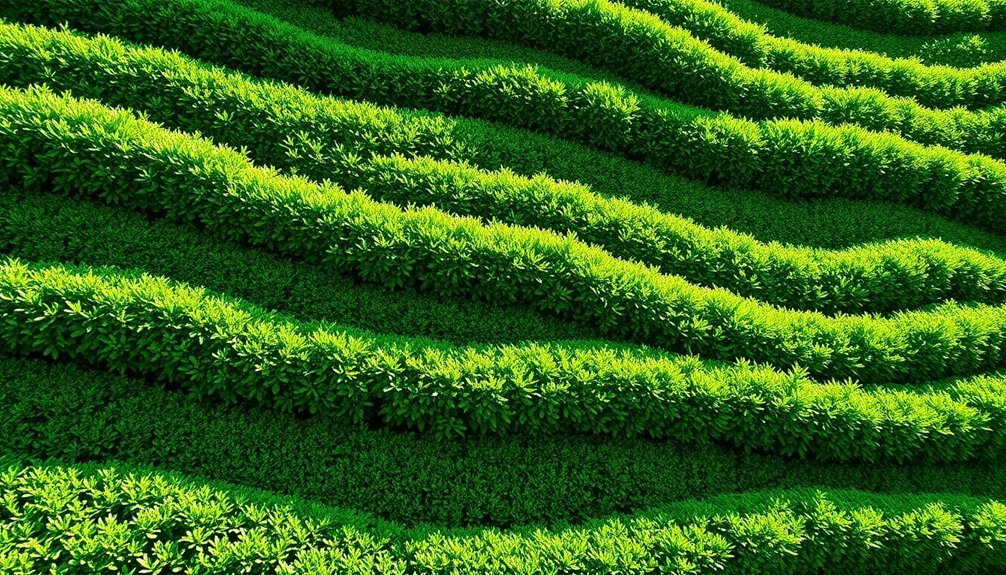
When creating multi-tiered hedges, you'll achieve the best visual impact by implementing staggered planting patterns that create depth and dimension.
For maximum effect, position taller species in the back row with 50% increased spacing between rows, while placing shorter, denser plants in the front tier at closer intervals—typically two-thirds of their mature height apart.
Your strategic layering will create dynamic visual interest throughout the seasons, especially when you combine plants with contrasting textures and complementary growth habits. Consider creating cross-sectional drawings before planting to better visualize how your multi-tiered hedge will develop and fit within your garden's overall design scheme.
Staggered Planting Patterns
Creating a multi-tiered hedge with staggered planting patterns requires careful planning to achieve maximum visual impact. Position plants approximately 33 cm apart, adjusting spacing based on mature size to prevent overcrowding. Offset each row to fill gaps and create a solid, cohesive screen.
You'll want to combine plants with similar growth rates to maintain even development while incorporating varied textures and colors for visual depth. Mix evergreens with deciduous species for year-round interest and seasonal transformation. For greatest aesthetic appeal, arrange plants in odd numbered groups throughout your hedge design.
Consider layering heights strategically—taller plants at the back, shorter varieties in front—to enhance dimensionality.
When planting, spread roots carefully and avoid placing organic matter directly beneath them to prevent root disturbance. This staggered approach not only creates aesthetic appeal but also provides environmental benefits like improved wildlife habitat and effective windbreaks.
Strategic Layering Techniques
Strategic layering transforms ordinary hedges into spectacular living landscapes with remarkable visual depth. When arranging your multi-tiered hedges, follow the principle of size gradation, placing taller plants in the background and shorter ones in front to create visual harmony.
Remember to allow adequate spacing between layers—typically 3-5 feet—for proper growth, air circulation, and maintenance access.
For maximum visual impact:
- Combine different textures and foliage types while maintaining color cohesion
- Incorporate both evergreen and flowering species for year-round interest
- Position layers to create natural shifts between garden spaces
- Guarantee each layer remains visible without overwhelming others
The space between your layers is as important as the plants themselves. This thoughtful spacing creates the illusion of depth while allowing each plant to showcase its unique characteristics. Consider implementing regular trimming for maintenance to ensure your multi-tiered hedge retains its intended shape and continues to thrive over the long term.
Creating Wildlife Habitats Within Your Living Boundary
Your multi-tiered hedge can serve as a crucial wildlife sanctuary when you incorporate diverse native plants that provide food and protection throughout the seasons.
By selecting berrying shrubs, flowering perennials, and seed-bearing plants native to your region, you'll create natural foraging opportunities for birds, pollinators, and small mammals.
The varied structure of your living boundary—with its multiple layers and dense coverage—offers essential nesting sites, protection from predators, and safe corridors for wildlife movement between larger habitat areas. Consider including features that enhance habitat connectivity between your hedge and other natural areas in your landscape.
Shelter and Foraging Spaces
While adding visual appeal to your property, multi-tiered hedges serve as essential sanctuaries for local wildlife seeking shelter and food. They create diverse vegetation layers that maximize both foraging opportunities and protection from predators.
Your layered hedge can support wildlife in several key ways:
- Dense lower shrubs provide escape cover for small mammals like eastern cottontails and ground-nesting birds.
- Mid-level branches offer perching sites for songbirds and support for bee hotels.
- Taller trees create nesting opportunities and form movement corridors for various species.
- Edge habitat formed between your hedge and lawn or garden attracts edge specialists like indigo buntings.
Including native plant species in your hedgerows ensures they provide the four essential components that wildlife require for their survival and reproduction.
Native Plant Selection
Native plants form the backbone of any wildlife-friendly hedge, providing food, shelter, and breeding sites that non-native alternatives simply can't match.
When selecting species, prioritize local varieties that support pollinators and birds through flowering shrubs like coneflower and structural plants such as arrowwood viburnum.
Source your plants from local nurseries that specialize in native species, and always ask about their origin. True natives offer greater ecological benefits than cultivars, which may lack the same wildlife appeal.
Remember to match plants to your soil conditions and climate for ideal growth.
Create diversity by incorporating flowering shrubs, native grasses, small trees, and groundcovers. These multi-layered plantings increase habitat biodiversity while creating visual appeal in your hedge.
This layered approach not only creates visual interest throughout the seasons but also maximizes the ecological function of your living boundary.
Seasonal Considerations for Year-Round Appeal
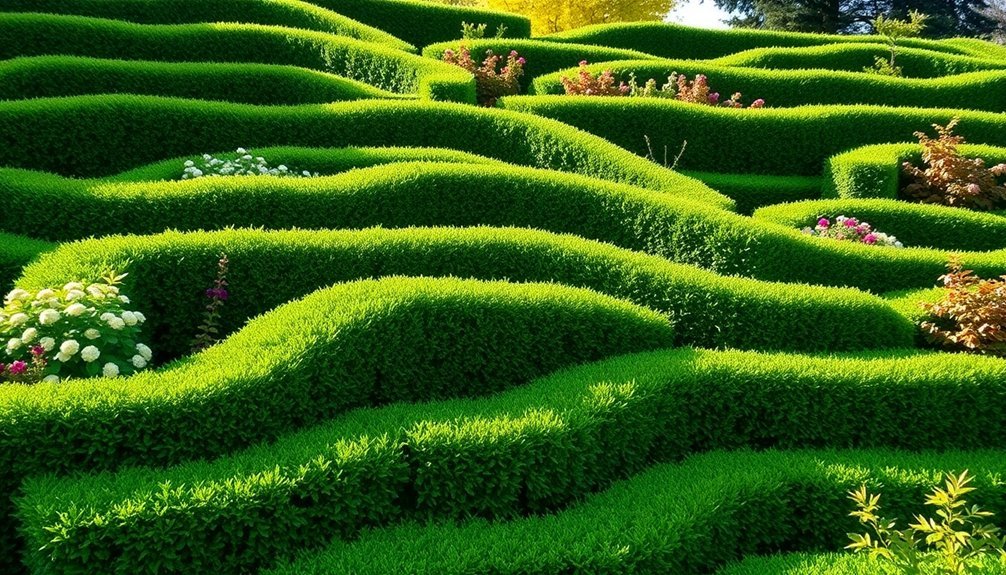
Creating a multi-tiered hedge with year-round visual interest requires thoughtful planning that accounts for seasonal changes and climate variations.
You'll want to incorporate both evergreen and deciduous species to maintain structure during winter while enjoying seasonal blooms and foliage changes throughout the year.
Consider your regional climate when selecting plants—coastal areas need salt-tolerant varieties, while urban settings benefit from pollution-resistant options.
Time your planting strategically, with spring and autumn offering ideal conditions for establishment. While traditional wisdom favors these seasons, summer planting is also possible with proper watering and protection from extreme heat.
- Mix fragrant hedging plants like lavender for summer sensory appeal
- Include wildlife-supporting species to attract beneficial insects and birds
- Layer drought-tolerant plants in hotter, drier sections of your garden
- Incorporate plants with winter interest such as colorful stems or persistent berries
Essential Maintenance Practices for Tiered Hedges
Maintaining multi-tiered hedges requires consistent attention to guarantee their structural integrity and visual appeal throughout the seasons.
You'll need to trim regularly every 3+ years, starting from the bottom to confirm even shaping while occasionally raising cutting heights to promote flowering.
Keep your hedge dense by preparing soil with compost, maintaining consistent moisture (especially for new plantings), and applying slow-release fertilizers in early spring. Incorporating traditional inosculation techniques can significantly strengthen the structural integrity of multi-layered hedges, especially for species with thin bark.
A lush, thriving hedge demands enriched soil, regular watering, and timely fertilization for optimal density.
Mulch around the base to suppress weeds and retain moisture.
For ideal structure, manage all components – shrubs, trees, base, and margins – while employing traditional techniques like laying and coppicing for rejuvenation.
Consider staggered planting patterns for greater depth and use multi-species layers at varying heights to enhance both visual interest and biodiversity.
Small Space Solutions: Adapting Layers for Limited Areas
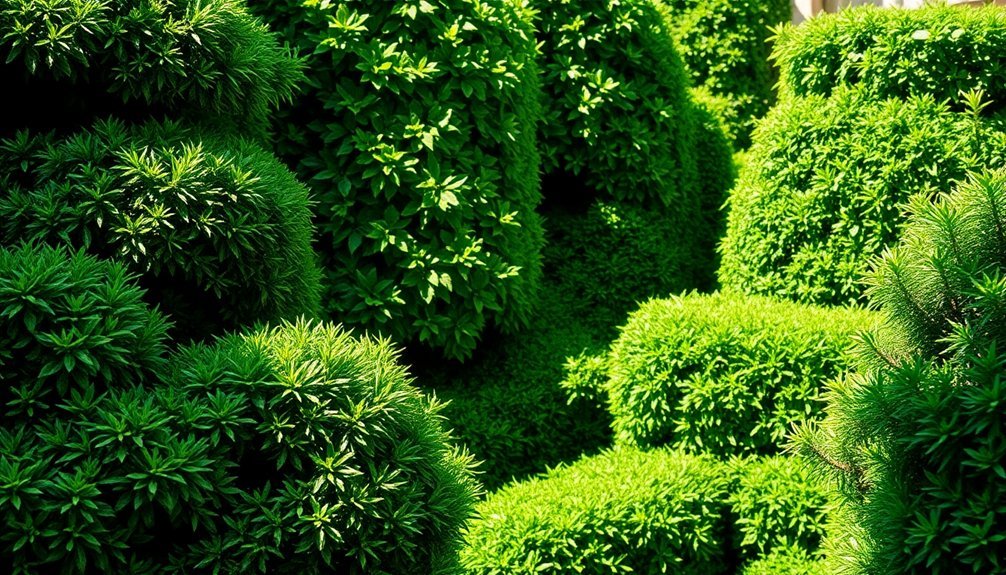
When space comes at a premium, multi-tiered hedges can still flourish through strategic adaptations and thoughtful design choices.
Container planting allows you to create versatile green screens on balconies, courtyards, and rooftops without permanent installation. Small-scale hedges can effectively define garden zones while maintaining visual interest in compact urban settings. Compact or slow-growing varieties prevent overwhelming limited areas while still providing depth and texture.
You'll find these small-space adaptations particularly effective:
- Use potted hedges for flexibility to rearrange as needed
- Incorporate mixed species for year-round interest in minimal footprint
- Layer plants by height to create the tiered effect without excessive width
- Choose container-friendly varieties that thrive in restricted root zones
These approaches deliver the biodiversity benefits and aesthetic impact of larger tiered hedges while respecting spatial constraints, often at lower cost than built privacy solutions.
Case Studies: Transforming Landscapes With Strategic Layering
Exemplary landscapes around the world demonstrate how strategic hedge layering transforms ordinary spaces into extraordinary environments. In San Francisco Bay Area, layered hedges create intimate seating lounges and private screening areas, perfectly balancing seclusion with style. A Secluded Seating Lounge in this region utilizes Bright n Tight Carolina laurelcherry along the perimeter to soften borders and create intimacy.
The renowned Plane Tree Cube in Germany showcases how designers integrate hedges into architectural statements that serve both aesthetic and functional purposes. Traditional techniques like pleaching, hedge laying, and espalier are being reimagined in urban settings, where they simultaneously provide privacy and reduce pollution.
You'll find these principles at work in urban parks, where studies show that thoughtfully designed hedges improve perceived safety and visual appeal.
Commercial landscapes benefit similarly, with strategic layering creating natural barriers that enhance ambiance while preserving ecological benefits like soil conservation and wildlife habitat.
Frequently Asked Questions
How Do Multi-Tiered Hedges Affect Property Boundary Disputes?
Multi-tiered hedges can complicate your property disputes by obscuring original boundaries, potentially supporting adverse possession claims, and creating confusion over maintenance responsibilities. They'll often serve as negotiation points in dispute resolution.
Can Multi-Tiered Hedges Be Effectively Grown in Containers?
Yes, you can effectively grow multi-tiered hedges in containers. Select compact varieties, use adequate pot sizes, and arrange them at different heights. They'll require regular watering, quality soil, and proper pruning to thrive.
How Do Hedges Impact Home Insurance Premiums?
Hedges don't directly impact your home insurance premiums, but they may indirectly affect costs by increasing property value and potentially offering some protection against minor weather events or debris damage.
Are There Smart Irrigation Systems Specifically Designed for Layered Hedges?
Yes, you'll find smart multi-zone irrigation systems with drip emitters perfect for layered hedges. They allow customized watering schedules for each tier, adjusting flow rates based on specific plant needs throughout your hedge layers.
What Lighting Options Enhance the Beauty of Multi-Tiered Hedges at Night?
For multi-tiered hedges at night, you'll create stunning depth by combining uplighting (highlighting texture) with downlighting (creating moonlight effects). Add string lights or puck lighting for focal points and use smart controls for automation.
In Summary
Multi-tiered hedges aren't just boundaries—they're living masterpieces that transform your landscape. By combining compatible plants with strategic spacing, you've created depth, texture, and wildlife habitat all in one. Remember to adapt your design to your space and maintain seasonally for year-round beauty. Whether you've got acres or just a small garden, these layered sanctuaries connect you to nature while enhancing your outdoor living experience.



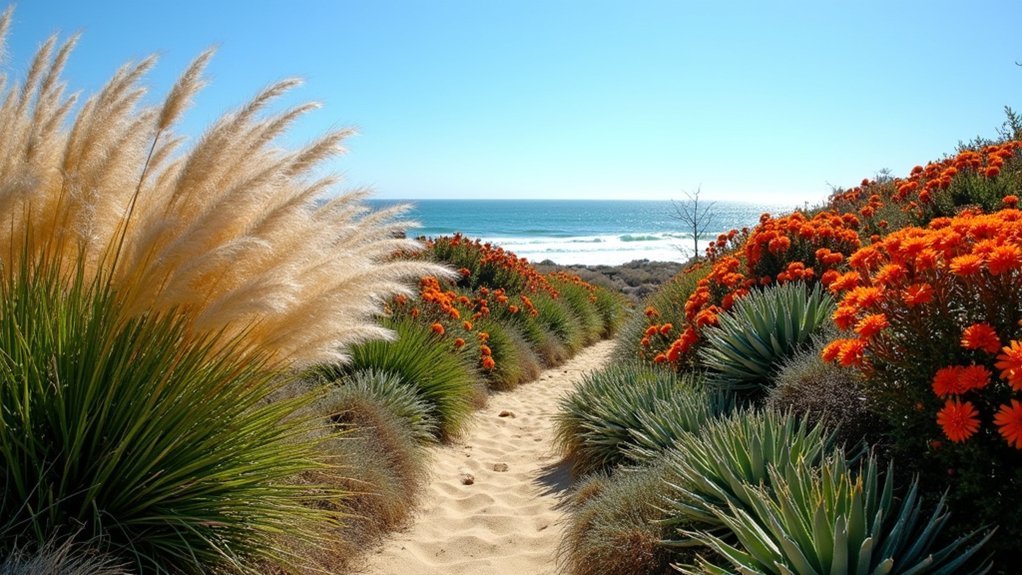
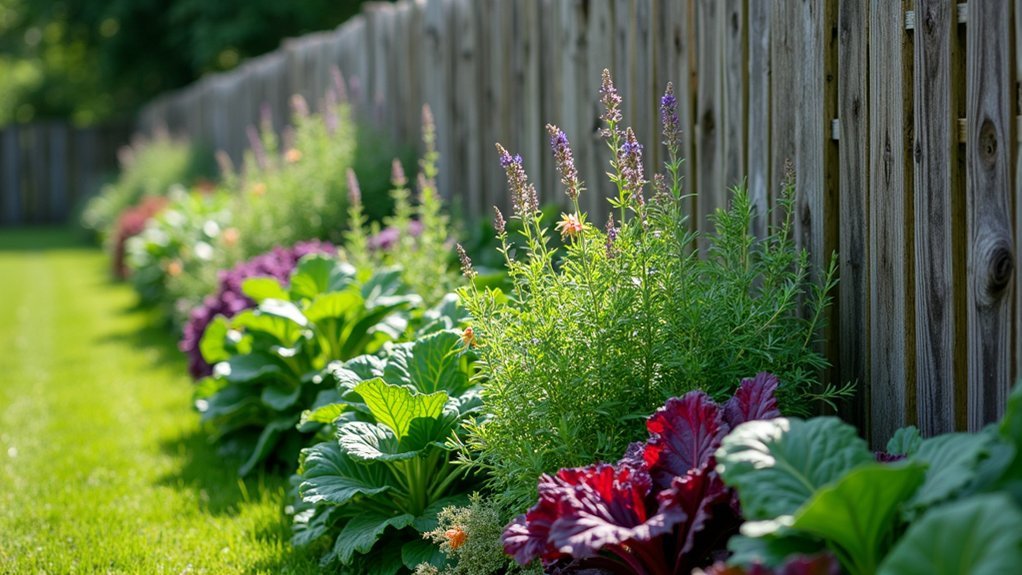
Leave a Reply